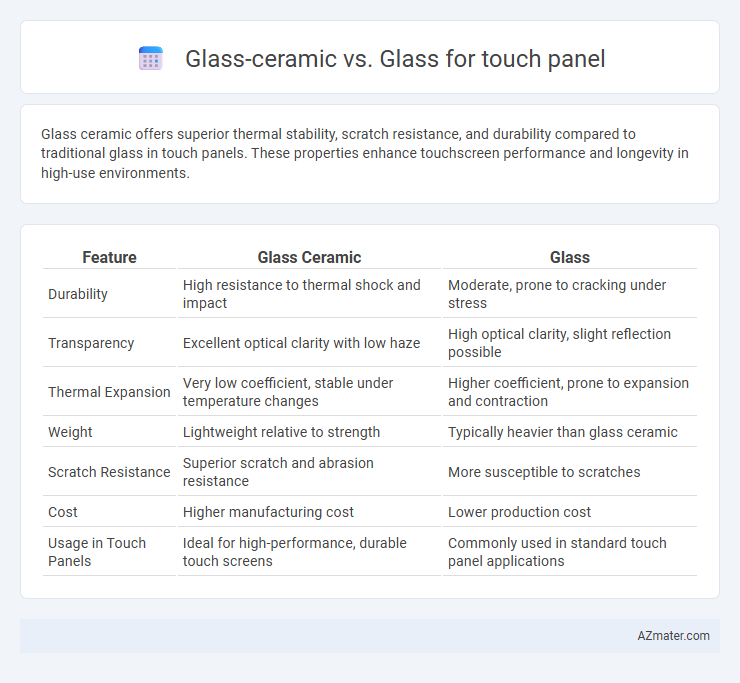Glass ceramic offers superior thermal stability, scratch resistance, and durability compared to traditional glass in touch panels. These properties enhance touchscreen performance and longevity in high-use environments.
Table of Comparison
| Feature | Glass Ceramic | Glass |
|---|---|---|
| Durability | High resistance to thermal shock and impact | Moderate, prone to cracking under stress |
| Transparency | Excellent optical clarity with low haze | High optical clarity, slight reflection possible |
| Thermal Expansion | Very low coefficient, stable under temperature changes | Higher coefficient, prone to expansion and contraction |
| Weight | Lightweight relative to strength | Typically heavier than glass ceramic |
| Scratch Resistance | Superior scratch and abrasion resistance | More susceptible to scratches |
| Cost | Higher manufacturing cost | Lower production cost |
| Usage in Touch Panels | Ideal for high-performance, durable touch screens | Commonly used in standard touch panel applications |
Introduction to Touch Panel Materials
Glass ceramic offers enhanced durability and thermal stability compared to conventional glass, making it an ideal choice for touch panel substrates in harsh environments. Unlike standard glass, glass ceramic exhibits lower thermal expansion, reducing the risk of cracking under temperature fluctuations. The combination of high transparency and mechanical strength in glass ceramic optimizes touch sensitivity and longevity in advanced touch panel applications.
Overview of Glass and Glass Ceramic
Glass used in touch panels offers excellent optical clarity, high transparency, and smooth surface properties essential for precise touch sensitivity. Glass ceramic combines the strength and thermal stability of ceramics with the transparency of glass, providing enhanced durability and resistance to fractures under mechanical stress. Both materials serve critical roles in touch panels, with glass ceramic favored in applications demanding higher impact resistance and thermal shock tolerance.
Optical Clarity and Transparency
Glass ceramics exhibit superior optical clarity and maintain consistent transparency with minimal light diffusion, making them ideal for high-precision touch panels. Conventional glass offers decent transparency but is more prone to surface scratches and haze, which can degrade visual performance over time. Enhanced formulations of glass ceramics provide sharper display clarity and better resistance to environmental factors, ensuring long-lasting optical performance in touch-sensitive devices.
Scratch and Impact Resistance
Glass ceramic touch panels offer superior scratch resistance compared to traditional glass due to their crystalline structure, which enhances surface hardness and durability. Impact resistance in glass ceramic is significantly higher, enabling better protection against drops and mechanical shocks, making it ideal for rugged devices. The combination of thermal stability and mechanical strength in glass ceramic materials reduces the likelihood of cracks and chips, outperforming standard glass in demanding touch panel applications.
Thermal Stability and Heat Tolerance
Glass ceramic touch panels exhibit superior thermal stability and heat tolerance compared to standard glass, maintaining structural integrity at temperatures up to 1200degC due to their controlled crystallization process. Standard glass typically withstands lower temperatures around 500degC before softening or deforming, making glass ceramic ideal for high-temperature applications in industrial touchscreens. Enhanced thermal shock resistance in glass ceramics reduces the risk of cracking or warping during rapid temperature changes, ensuring durability and reliability in demanding environments.
Durability and Longevity in Use
Glass ceramic exhibits superior durability compared to standard glass, offering enhanced resistance to scratches, thermal shock, and mechanical impact, which significantly extends the lifespan of touch panels. Its robust structure reduces the likelihood of cracks or fractures under stress, maintaining touch sensitivity and display clarity over prolonged use. In contrast, conventional glass panels are more susceptible to damage from daily wear and temperature fluctuations, leading to shorter operational longevity and increased maintenance costs.
Manufacturing Process Differences
Glass ceramic and glass differ significantly in the manufacturing processes used for touch panels, impacting their performance and durability. Glass ceramic undergoes a controlled crystallization process during heat treatment, which enhances its thermal stability and toughness, while traditional glass is produced by rapid cooling of molten silica to form an amorphous structure. The precision required in crystallization for glass ceramic results in higher manufacturing complexity and cost compared to the simpler float glass or tempering methods used for regular glass touch panels.
Cost Comparison: Glass vs. Glass Ceramic
Glass panels typically offer a lower initial cost compared to glass ceramic due to simpler manufacturing processes and widely available materials. Glass ceramic touch panels, while more expensive upfront, provide superior durability, scratch resistance, and thermal stability, potentially reducing long-term replacement and maintenance expenses. Cost efficiency depends on application requirements, with glass panels favored for budget-sensitive projects and glass ceramic preferred in high-performance, rugged environments.
Applications in Modern Touch Panels
Glass ceramic offers superior scratch resistance and thermal stability compared to traditional glass, making it ideal for high-performance touch panels in industrial and medical devices. Its low thermal expansion minimizes warping under temperature fluctuations, enhancing durability in automotive and outdoor applications. Glass, while more cost-effective and widely used in consumer electronics, lacks the enhanced mechanical strength required for rugged environments.
Choosing the Right Material for Your Touch Panel
Glass ceramic offers superior durability and thermal stability compared to standard glass, making it ideal for high-performance touch panels exposed to frequent use or temperature fluctuations. Its enhanced resistance to scratches and cracks ensures a longer lifespan and maintains optical clarity, which is critical for touch sensitivity and user experience. Opting for glass ceramic can reduce maintenance costs and improve overall reliability in demanding environments.

Infographic: Glass ceramic vs Glass for Touch panel
 azmater.com
azmater.com